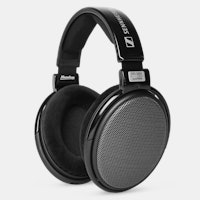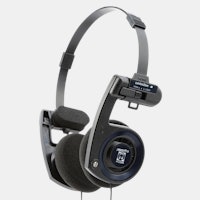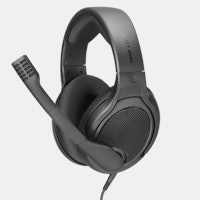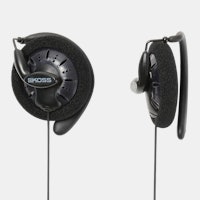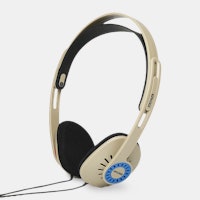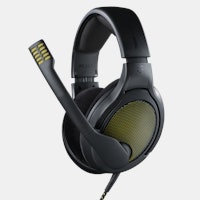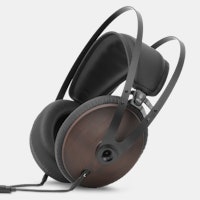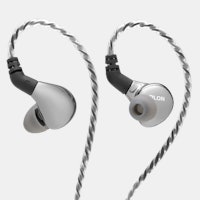Click to view our Accessibility Statement or contact us with accessibility-related questions


















Is Bluetooth as Good as a Wired Connection?
Back when I visited CanJam NYC in 2016, I got to talking to the two founding members of Bluewave, and had an extended conversation and demo of their soon-to-release Bluetooth receiver/DAC/Amp, the GET. They argued that the quality of Bluetooth has reached a point where the internal components used had a bigger impact on the final sound quality than the fact that it was wireless, and their device would have better sound quality than the headphone jack in my smartphone. I thought this was an interesting challenge, and I had to research and rethink my perspective on Bluetooth audio.
You see, Bluetooth is a digital transmission, so it bypasses capacitance and EMI factors of headphone cables. Then, the Bluetooth receiver must then use a DSP (like a computer) to decode and decompress the transmission, a Digital to Analog Converter (DAC) and an Amplifier before outputting to the headphone transducer (speaker). When you buy a Bluetooth receiver, you’re also buying a DAC and an amp! With a made-for-Audio Bluetooth receiver, all the components inside have the opportunity to be built to higher spec than what is included in a smartphone or laptop.
The current state of Bluetooth audio is different than most people realize, and better than the stigma. There are advantages and disadvantages, besides not having a cord coming from your pocket.
Shortlist of +Pros and -Cons
+High res Bluetooth codecs (aptX HD, LDAC, LHDC) don’t have to re-compress Spotify Premium streams and have little to no compression added to FLAC streams close to CD quality (TIDAL HiFi, Qobuz high res).
+Bluetooth can extend further than most wires included with headphones, and also pass through thin walls without drilling a hole.
+Wires (especially longer wires) can affect the sound reproduction, but Bluetooth is transmitted digitally with error correction, and the BT receiver, DSP, DAC, Amp, and headphone transducer/speaker are either point-to-point soldered together or have very short signal paths.
+The DAC and Amp can also be tailored to match the headphone.
The downsides:
-Latency is reduced but still present.
-While Bluetooth range is pretty long, sometimes it can be blocked by walls or subject to interference when many Bluetooth signals are blasting nearby.
-Bluetooth headsets are limited by battery life, and the source (I.E. your phone) drains battery a little faster than a wired connection.
-A battery and other electronics in a headphone/headset mean more weight and bulk, which is often the reason behind neckbands or short battery life in True Wireless IEMs.
-Bluetooth audio can only be sent to one device, so no silent discos.
Bluetooth 5 and 5.1
Back when the Sony Xperia XZ Premium, iPhone 8/X, and Samsung Galaxy S8 were coming out with Bluetooth 5 in 2017, I got really excited about its increased power that could be used for range or data transmission rate. Figures like 2 Mbit/s burst transmission at short range or lowering the transmission rate to achieve over 300 feet of range boggled my mind, and had me thinking Bluetooth could become an alternative for WiFi in some cases. However, I later learned that those high figures were only possible with two “class 1” Bluetooth devices (both transmitter and receiver), and that in a more practical sense these Bluetooth codecs would mostly affect advertising and “Internet of Things” devices. Bluetooth audio would remain mostly the same as the 4.2 era, with about the same 30 foot range and the audio bitrate determined by the Bluetooth codec.
Codec Conundrums
Want to stream Spotify Premium, Apple Music, or a social service like YouTube and Facebook? Bluetooth that supports AAC or aptX will be enough to transmit the audio without further compression. Want to stream TIDAL or Qobuz Hi Res tiers of service? Qualcomm’s AptX HD, Sony’s LDAC, and Savitech’s LHDC can carry higher bitrates, and at short range in a good environment LDAC and LHDC can “carry” most of a CD-quality FLAC amount of data, but they’ll probably need to compress the data just a little. AptX Low Latency and similar codecs interest me the most for gaming, because lag is always our enemy!
Wireless Options
We’re seeing many releases now for Bluetooth. There are the traditional on-ear/over ear headphones, neckband IEMs, what I’ll call neck-wire IEMs, and True Wireless IEMs, as well as Bluetooth Receivers.
On/Over-ear headphones were the first type of Bluetooth Headphones, but these days some manufacturers are beginning to experiment with Hi-Res Bluetooth headphones that are meant for serious listening.
Accessory neckbands that add Bluetooth to existing IEM models or are hardwired to rereleases of earpiece capsules (for example, the IE 80S BT or the CX 7.00bt from Sennheiser) add flexibility, and put the weight of the battery, remote controls, and electronics on your neck instead of hanging on your ear, and they often use the extra space for larger batteries and sometimes dual microphones for noise cancellation. Neckbands are also an easy solution for how to share one Bluetooth connection between the left and right channels. Neck-Wire Bluetooth IEMs, such as the Sennheiser Momentum Free, have an in-line “pod” hanging from the ear with the electronics, a shorter battery life, but they are flexible and easier to fold up into a small pocket-sized case.
True Wireless IEMs deserve their own paragraph here! They may be the newest, hottest thing, but they’re tricky to do well. First thing people realize is the earpiece battery life is shorter than we’re used to, and almost all of these come with a “charging case” that is essentially a battery bank... but I only use IEMs for one or two hours at a time before needing a break, and I recommend thinking about how long a typical IEM session comfortably lasts. These are intended as everyday carry devices, so charging at night or after long-term storage is to be expected. Second, how to sync and share audio between the left and right ear pieces? I’ve had different engineers tell me that basically the best way to go is NFMI, or Near Field Magnetic Induction. Bluetooth has difficulty transmitting through water or dense materials – like our bodies – so magnetic induction is better because it can go through or around the head to keep the earpieces in sync. One earpiece has to be the “Master,” so that’s why usually there’s one earpiece that drains battery faster than the other side. Thirdly, they’re a bit heavier than wired IEMs.
Bluetooth Receiver devices are a new category, and shouldn’t be overlooked. You could also call them a wireless adapter, because what you do is plug regular wired headphones or IEMs into this (usually little) device, and the device does everything from streaming the audio to powering your headphones. That way, if you already have a headphone with a sound you like, you can have your favorite flavor and get it in Wireless too. Some examples from this category are the Bluewave GET, Radsone ES100, FiiO BTR3, iFi XCan, and many more units from companies like Astell and Kern, Creative Labs, Beyerdynamic, etc. There are also a number of Digital Audio Players (DAPs) that also have a 2-way Bluetooth function, so they can also act as wireless adapters in addition to being their own source of audio. Some examples of 2-way Bluetooth DAPs include the newer Sony Walkmans (Walkmen?), Hiby DAPs, FiiO DAPs, Shanling, Cayin, Acoustic Research, and more.
DLNA servers or Airplay over WiFi are still going to be our uncompressed digital wireless solutions for now, and RF Wireless is still going to be the lag-free solution that should appeal most to gamers, though RF options are fewer now than they once were.
Wireless and Gamers
Well, the biggest issue I’ve seen is lag. Bluetooth receivers have work to do before they can playback sound. Furthermore, if Chat with a microphone channel is meant to send audio back to the gaming device, that cuts into the total available bandwidth and only certain audio codecs support an audio return channel. Games like PUBG Mobile switch to audio codecs usually meant for phone calls, which leads to noticeable drops in the game audio quality. That’s why Turtle Beach, Astro, and other gaming headset makers have often made “headset and base” combo units, using RF instead of Bluetooth. Sennheiser’s new GSP 670 and GSP 370 use a USB dongle that acts as an 2.4 GHz RF transmitter instead of using a big base station, and the GSP 670 only has Bluetooth 5 as a secondary transmission option for mobile devices. Lastly, wireless bandwidth, whether Bluetooth or RF, is usually only enough for stereo playback... so if you want a true binaural “Surround Sound” mix, the processing has to be done before transmission, otherwise the two channels of information are only really suitable for emulating two speakers in front of you.
However, I see some hope! Again, AptX LL helps a lot with the latency issue. And I don’t know what codec is supported with Call of Duty Mobile on my iPad, but I have a certain Planar Magnetic Bluetooth Gaming headphone that performs much better in the new game than PUBG, essentially with playable latency and much better audio quality!
Conclusion
Personally, I’ve observed huge advancements in Bluetooth audio over the years. Much of the old stigmas have been addressed, and I’m excited to see where the future takes us.
Bio: I am Evshrug here, Head-Fi, Instagram, Twitter, Twitch, and on YouTube. I got into audio because I wanted a more immersive gaming experience, and I write because I want to help people and share what I learn. Currently, I consult for a few audio companies including Sennheiser and Dekoni, but my statements don’t represent those companies (and their level of knowledge). Learning is always a work in progress, so feel free to add sources and help out :)
A link to all my blog posts: http://www.head-fi.org/t/646786/evshrugs-if-i-knew-then-what-i-know-now-discussion-journal
(Edited)

search
close
Sort by: Newest
keyboard_arrow_down
SuperShibe
29
Jan 27, 2022
This is a lot of good information, but I'm still sticking to wires. Personally, I don't need any cables long enough to introduce noticeable noise or distortion. Bluetooth also costs more, and the best products don't necessarily offer bluetooth, so I don't feel obligated to limit myself to it. Not to mention that converting the bluetooth signal to digital is a completely unneeded potential point of distortion, or that I would need to manage batteries and/or recharge the device.
I don't have a lot of high resolution music yet, and I'm not opposed to using bluetooth entirely either (I use it with my car and it still sounds great, but I didn't pay any extra to put it in and my phone's dac sucks anyways)
Anyways, thanks for sharing information with the community. Cheers!

Evshrug
4131
Keyboard Club Member
Jan 27, 2022
SuperShibeYeah! I wrote this years ago, after realizing Bluetooth had way more potential than I thought.
I still bemoan the loss of headphone jacks on smartphones, the marketing that wired is now either “antiquated” or a “pro/premium feature” that you have to pay extra for (seriously, there isn’t a good reason for the headphone jack to have been removed from the new Mac mini). I still know wired has less latency when I’m gaming. I also think using Bluetooth with analog playback sources, like Vinyl, completely misses the point of both Bluetooth and using an analog source.
However, Bluetooth is currently really nice for connecting to sources without adapters, frayed cables, snags, tangles, and knots, etc. Looking at my car’s radio, desktop computer, video streamer, smart TV, smartwatch, tablet, and even my smartphone, it’s looking like more devices have Bluetooth than headphone jacks. So, thank goodness we’ve progressed to the point where Wireless audio doesn’t HAVE to sound robotic and fatiguing, and there are new wireless codecs and faster processors that almost clear up gaming latency.
I wrote the bluetooth article here several years ago, but now as of early December. I started working with a new headphone company with a vetern acoustic engineer of the headphone industry in late November 2021. And guess what? Our first product is a pair of true wireless in-ear headphones, and I happen to think they help push the boundaries of wireless sound quality in all the ways I mentioned above :)
l33tplaya
1
May 20, 2021
Bandwidth? This seems to have been completely ignored. Best Bluetooth can't do even full CD quality. So I think you were misled by marketing folks re quality of components being *more* important. Maybe more important compared to existing BT implementations, but not compared to a very good wired set.

Evshrug
4131
Keyboard Club Member
May 24, 2021
l33tplayaWhile it’s true that currently LDAC and LHDC codecs are limited to about 900 kbps, bluetooth 5 can support up to 2 mbps. As a formerly common baseline, the low loss CD format AIFF uses 1411 kbps... but compression techniques like FLAC have greatly advanced since the days of optical discs which are fading fast in the rear view mirror (https://pitchfork.com/news/vinyl-outsells-cds-for-the-first-time-in-decades/amp/). Also, with most music consumed these days in a streaming format well within existing Bluetooth codec’s kbps envelope, a wired or wireless connection would make little difference.
But that’s not even the biggest point... you have to consider the connections as part of a system and a chain of components to supply the audio. No, Bluetooth will not surpass the maximum quality possible with wired: I would happily take my $1400 headphones + $500 wire + $2400 DAC/amp + $12 decent USB cable + HDTracks hi res files over any current Bluetooth setup on the market when at my office desk... but not everyone’s setup will be like that, nor will that always be a setup that can be used in certain situations. A Bluetooth headset (or a Bluetooth adapter like the Earstudio ES100, Bluewave GET, FiiO BTR5 or Q5S, etc) should also be considered as a DAC/Amp component too. A wired headphone connected to a built-in headphone jack on a laptop could easily have its sound quality surpassed by a Bluetooth headset with low internal noise, a good DAC filter and programming, and an amp with low distortion and good power. A wired connection can vary widely depending on the components further up the signal chain, while a Bluetooth headset will have had its components carefully selected to have good synergy with the headphone.
So, yes, the maximum possible quality goes to a wired connection. However, so many other components or compression levels that bottleneck quality more than Bluetooth does in many (most???) typical setups. I’m far from against wired connections, and I sincerely wish they were still a common option on smartphones and I totally intend to set up a wired connection for my PS5 when it arrives in the mail (tomorrow!!!). However, Bluetooth is far more advanced from its early days and continues to develop, and is at a point now where we review our stigmas.
Lastly, I’m not doing marketing by saying this... I don’t have any connections to FiiO, Bluewave, or Earstudio other than being a customer of a few of their products and talking to them at audio shows. This is just an opinion piece that presents the evidence and experiences I’ve had, and a bit of a prediction of the future.

newbee
28
Feb 22, 2021
Hi Evshrug, thanks for the info. Thanks for being one of those people who like to learn,be curious and share what you have attained. We are all better off, if we in turn take the time to do the same. Be safe and carry on. Cheers Leonard.

Evshrug
4131
Keyboard Club Member
Apr 5, 2020
mrkb34And thank you for the thumbs up! Sometimes it’s good for me to coalesce my thoughts into one article. It helps other people and I can link to it instead of retyping parts of it as a response to someone.
Plus, as much as I want to help and explain to people here, I’m also trying to convince Mfrs as well... the tools for HiFi bluetooth are here and improving, and I’d like to see more efforts towards HiFi BT headphones. The more that people like you make reference to and share a write-up like this, the more likely mfrs will see it.
(Edited)

Evshrug
4131
Keyboard Club Member
Oct 24, 2019
KoltaiPGlad I could help! Feel free to bookmark this, and share the link if you see anyone else asking about Bluetooth :)

Evshrug
4131
Keyboard Club Member
Oct 17, 2019
RayFOn one hand, it’s a closed system, so it could be balanced from the DAC through the amp (and cables), so it would be easy to do.
On the other hand, it’s such a short cable run, and you basically could get all the same benefits from other parts of the design.
So, it’s not going to make much of a difference, but on the other hand, if it’s basically the same price and a good sounding system overall, why not?
(Edited)

Evshrug
4131
Keyboard Club Member
Feb 12, 2020
RayFTo add to this response, a practical example: My Sony Walkman ZX300A has 50 mW per channel (@32 Ω) on the single-ended output, while the balanced Pentaconn output offers 200 mW (@32 Ω) per channel. The SE output is great with IEMs, plenty of power without too much gain and no background hiss with the IEMs I’ve tried, while the BAL output sounds wonderful with my HD 660 S full-sized headphone.
If you think about it, Pretty much all speakers are wired in Balanced. The longer the cable run, the more apparent the benefits of Balanced become. You can find research on websites that actually shows audio engineering formulas expressing the capacitance (or was it resistance? I forget off the top of my head) of wires in relation to the length of the wire. Most headphone cables are short, but the differences should be audible for those 3M “listening chair” setups.
Sony COULD have shortened the battery life and just made the SE output more powerful, and then it might have sounded very close to the sound from the BAL output when on-the-go (with short cable lengths). The volume for sensitive headphones would also have to be kept pretty low. In this case, having both the SE and Balanced ports gives me a nice choice for use with IEMs/portable headphones and full-size “home” headphones.

Evshrug
4131
Keyboard Club Member
Feb 12, 2020
Oh, I don’t think I ever explicitly said it, but since the Sony ZX300A can act as a Bluetooth receiver (with some great high-quality codecs, and a good amp), I basically use this instead of the Radsone or Bluewave these days. Sounds really good!

ElectronicVices
2940
Feb 17, 2020
EvshrugI do greatly enjoy the two way BT of more modern DAP's... I picked up a FiiO M6 a while back (almost exclusively for BT use) and love it. Not the fastest UI but given it's size and cost it's a hell of a combo. I use it primarily to feed BT speakers and as a BT receiver from my phone when not carrying the Radsone.
PRODUCTS YOU MAY LIKE
Trending Posts in Audiophile
AntonetteCBak
Tips for Setting Up a Trading Desk with a Laptop
Creating an efficient and organized trading desk with just a Best laptops for trading requires a strategic approach to maximize productivity and trading success. Whether you’re a beginner or a seasoned trader, having the right setup ensures seamless execution of trades, minimizes errors, and keeps you focused. Below are essential tips to set up a professional trading desk using a laptop. Invest in a high-performance laptop tailored to trading needs. Opt for a model with a fast processor (e.g., Intel i7 or AMD Ryzen 7), at least 16GB of RAM, and a solid-state drive (SSD) for quick data access. Ensure the laptop has multiple ports for connecting peripherals and a high-resolution display for crisp chart visibility. Trading often involves monitoring multiple charts, news feeds, and trading platforms simultaneously. Connect your laptop to external monitors using HDMI or USB-C ports to expand your workspace. Dual or triple monitor setups allow for better multitasking and a...
Nov 21, 2024

abhinavkumar
Company Information in Dubai
Get comprehensive company information in Dubai, including registration requirements, licensing options, and compliance guidelines. Whether you’re exploring free zones, mainland, or offshore setups, our expert resources provide insights to help you make informed business decisions. Navigate Dubai’s business landscape with clarity, from legal requirements to operational support for a successful establishment. For more details:- https://leelainternational.com/
Nov 21, 2024

Leafwise
Show off your carry / bag / case / setup for your Head-Fi gear ✨
As subject, what do y'all carry your gear in for out-and-about/day-to-day and then for travel, if anything other than pockets?
Nov 19, 2024
keegu22
More bass!
I currently have the the HD 6XX, which sound great but, I'm am looking to upgrade the power of the bass as i really enjoy punchy low end EDM music. Any suggestions in the $200-$300 price range would be awesome.
Nov 13, 2024

danielj9
Trying to add Topping LA90D amp to Topping A9D preamp
Any help would be appreciated...I added an amp to my streamer, dac, headphone amp/preamp system and am now not getting any music through the headphone jacks on the preamp - the specifics: Wiim Pro Plus - optical connection to - Topping D50 iii dac - TSR to XLR connection to - Topping A9D headphone amp/preamp (all worked fine as a headphone amp until I tried adding:) - XLR connection to - Topping LA90 D amp. Amp switches are set to bypass, stereo, low gain. In this configuration, I am not getting any music to either my SE or XLR headphone jacks. I made sure I switched the A9D to "preamp" and "xlr" modes. I have no idea what I might be overlooking or missing...any thoughts would be deeply appreciated! Thank you.
Nov 11, 2024

Tremuh
Trying to find new headset
I currently am rocking the beyerdynamic DT 990 Pros and have been for a while now, along with a go xlr! I was trying to see what other headset you guys recommend along with something to replace the xlr? Thank you!
Nov 7, 2024

aiden.miller
Mic not working pc38x
I just got my pc38x in the mail today and the out put is quiet but fine and I'm happy. But the mic will not work when on my Xbox series and I was wondering if this issue can be resolved or if the head set is not compatible with Xbox.
Nov 4, 2024


